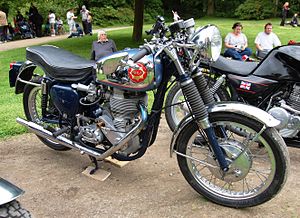 1956 DBD34 Gold Star (modified) | |
| Manufacturer | BSA |
|---|---|
| Production | 1939–1963 |
| Predecessor | 1936–1939 BSA Empire Star |
| Successor | 1971–1973 BSA B50[clarification needed] |
| Class | Standard |
| Engine | 348 cc (21.2 cu in) (B32) 496 cc (30.3 cu in)(M24) 499 cc (30.5 cu in) (B34) alloy air cooled OHV 2V pushrod single |
| Bore / stroke | M24: 82 mm × 94 mm (3.2 in × 3.7 in) B32: 71 mm × 88 mm (2.8 in × 3.5 in) B34: 85 mm × 88 mm (3.3 in × 3.5 in)[clarification needed] |
| Compression ratio | M24 7.75:1 (petrol) 12.5:1 (dope/alcohol[clarification needed]) ZB32 6.5, 8:1, 9:1, 13:1 B32 6.8:1, 7.5:1, 8:1, 9:1, 11:1 |
| Top speed | 110 mph (180 km/h) (varies by model and options)[1] |
| Power | Approx. 18–27 hp (13–20 kW) (M24 and B32) 34–42 hp (25–31 kW) (M34) (varies by model and options)[2][1] |
| Ignition type | Magneto |
| Transmission | Wet multiplate clutch, 4-speed, chain |
| Frame type | Steel full duplex |
| Suspension | Front: telescopic fork, Rear: rigid from 1939, plunger from 1954; swinging arm |
| Brakes | Front: single sided 7" competition models, and M24. 8" or full-width 190 mm for touring and racing models [clarification needed] drum cable actuated, hydraulic, Rear: 7" Drum, rod |
| Tyres | Front: 3.0×19" Rear: 3.5×19" |
| Wheelbase | 56 in (1,400 mm) |
| Seat height | 30.5 in (770 mm) |
| Weight | 380 lb (170 kg)[3] (dry) |
| Fuel capacity | 4 imp gal (18 L; 4.8 US gal) |
| Fuel consumption | 45 mpg‑imp (6.3 L/100 km; 37 mpg‑US)[3] |
| Related | BSA B33 BSA Rocket Gold Star |
The BSA Gold Star is a motorcycle made by BSA from 1938 to 1963. They were 350 cc and 500 cc single-cylinder four-stroke production motorcycles known for being among the fastest bikes of the 1950s. Being hand-built and with many optional performance modifications available, each motorcycle came from the factory with documented dynamometer test results, allowing the new owner to see the horsepower (bhp) produced.[4]
The Gold Star was almost continuously developed over its lifetime by BSA's engineers and riders, who improved its capabilities and increased output from its essentially simple push-rod petrol engine than had been thought possible[by whom?]. It was highly successful across almost all areas of motorcycle sport for well over a decade and is widely regarded by enthusiasts as a notable design of its era.[3]